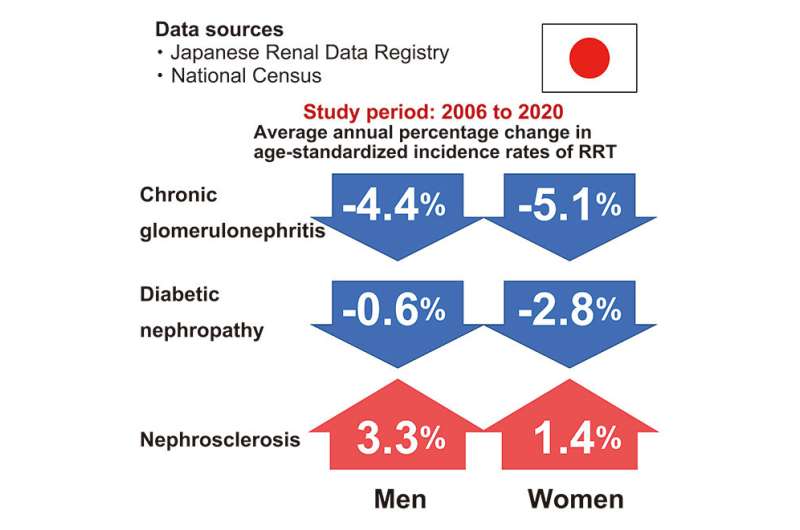Substantial rise in the incidence of renal replacement therapy due to nephrosclerosis in Japan

A new Japanese study reveals that the age-standardized incidence rates of end-stage kidney disease (ESKD) requiring renal replacement therapy (RRT) due to chronic glomerulonephritis and diabetic nephropathy has decreased, while rates due to nephrosclerosis have increased considerably between 2006 and 2020.
Age-specific incidence rates of RRT attributed to nephrosclerosis also increased in many age groups, suggesting that the increased number of patients with nephrosclerosis as a primary kidney disease is not only due to the increasing number of older people, but also due to increasing age-specific incidence rates.
The key findings include:
- Age-standardized incidence rates of RRT due to diabetic nephropathy significantly declined in both sexes, although not as steeply as the decline seen for chronic glomerulonephritis.
- The incidence rate of patients requiring RRT due to nephrosclerosis increased by 132% for men and 62% for women from 2006 to 2020, and the age-standardized incidence rate of RRT due to nephrosclerosis also increased considerably during this period in both sexes.
- Age-specific incidence rates of RRT attributed to nephrosclerosis also increased in many age groups from 2006 to 2020, suggesting that the increase in the number of patients with nephrosclerosis is not only due to increasing numbers of older people, but also, because of increasing age-specific incidence rates.
“We urgently need effective strategies to reduce the burden of ESKD requiring RRT in order to mitigate its expected financial and health burdens, because the number of patients with ESKD is projected to increase in the near future,” said Dr. Wakasugi, the corresponding author of the study. “Understanding recent trends in RRT incidence by disease type will help establish strategies to lower these rates in the general population.”
Using data from the Japanese Society of Dialysis Therapy registry and national census, the study revealed that age-standardized incidence rates of RRT due to nephrosclerosis increased significantly, by 3.3% (95% confidence interval (CI): 2.9 to 3.7) and 1.4% (95% CI: 0.8 to 1.9) per year for men and women, respectively.
The average annual percentage change of chronic glomerulonephritis at -4.4% (95% CI: -5.3 to -3.8) for men and -5.1% (95% CI: -5.5 to -4.6) for women) and diabetic nephropathy at -0.6% (95% CI: -0.9 to -0.3) for men and -2.8% (95% CI: -3.1 to -2.6) for women significantly decreased from 2006 to 2020.
“Our finding that age-standardized incidence rates of RRT due to diabetic nephropathy significantly declined is encouraging, because a previous study reported that the age-adjusted rate for diabetic nephropathy increased rapidly from 1983 to 2000. While our data cannot provide a definitive reason for the decreased incidence rates of RRT due to diabetic nephropathy, two factors—a stabilized trend in type 2 diabetes prevalence in the general population, and recent developments in strategies to reduce the progression of diabetic nephropathy—may have contributed,” said Dr. Wakasugi.
“The second important finding of our study is that the number and population incidence rate of new RRT cases due to nephrosclerosis have increased considerably during the study period. We urgently need effective strategies to reduce the burden of nephrosclerosis.”
Source: Read Full Article



